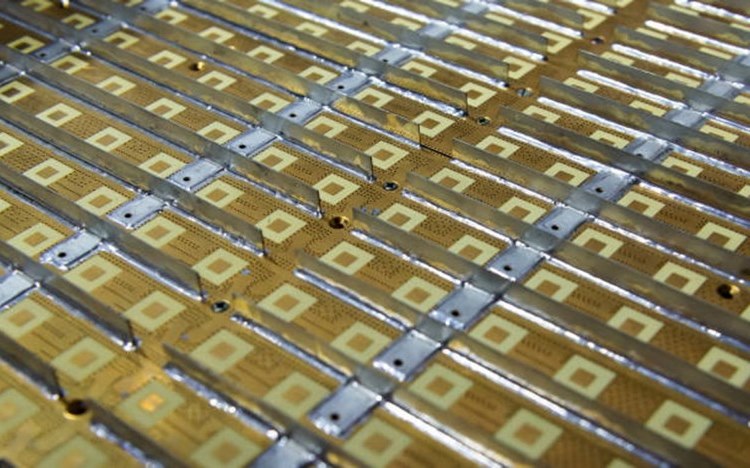 |
Beamforming for Satellite CommunicationsSatellite Communications (SatCom) is a vital market that plays a huge role in the global communications ecosystem. It supports a variety of applications, including navigation systems, military, weather monitoring, telecommunications, and more. The SatCom industry has turned to higher-frequency bands to support the ever-increasing demand for bandwidth, such as the X, Ku, K, and Ka bands. In an era where demands for high data rates are ever increasing, there is a need to focus on one of the key sections of the RF front end, , the antenna. Unfortunately, antennas are often overlooked in an RF design, which could prove to be extremely detrimental to overall system performance. For instance, in the case of an RF front end for a mobile phone, an RF engineer may try to squeeze in every fraction of a dB from transmission lines to PA matching to optimize linearity and efficiency of the design. However, if the antenna isn’t carefully considered, the engineer could face issues with sizing and proper functionality. Key Features of Parabolic Dish AntennasParabolic dish antennas have been traditionally used in ground stations in the SatCom industry. They have been the standard design, well established for their good performance, power consumption, and cost. However, dish antennas have some drawbacks, including being physically large and often slow to steer, having poor long-term reliability, and only having the ability to transmit and receive on fixed radiation patterns. Phased Array Antenna AttributesComparatively, phase array antennas are electrically steered and offer numerous benefits compared to traditional mechanically steered antennas, including low profile/ less volume, improved long term reliability, fast steering, and possessing multiple beams. The Mechanics of an AntennaAntennas convert RF signals into electromagnetic waves for transmission and vice versa for receiving. Each antenna has a radiation pattern that defines the direction of the energy radiated by the antenna. The Gain and Directivity are the key parameters of an antenna, the greater the gain of an antenna, the more directive the antenna becomes. This characteristic of an antenna makes it appealing for increasing the capacity for wireless systems such as 5G, SatCom, etc. MIMO technologies have been used widely in wireless systems such as Wi-Fi and more recently in Cellular/5G communications, to support high spectral efficiencies. A single antenna broadcasting a wireless signal radiates that signal in practically all directions. By focusing a signal in a specific direction, beamforming allows for a higher quality of signal to be received at the receiver without needing to increase the transmit power. The added benefit with beamforming, is the signals are not broadcasted in directions where it is not needed, thus reducing interference with other channels/systems. What is Beamforming?Beamforming is a signal processing technique that simultaneously sends or receives multiple signals at once both at the transmitter and receiver ends of multiple antenna arrays to increase system capacity and performance. Using this method, each antenna element is fed an independent transmit signal. Beamforming reduces interference and improves the signal to interference and noise ratio. Generally, beamforming can be classified as either passive or active beam forming. Passive beamforming is implemented by using fixed directive antennas and including passive components such as surface mount power dividers like the Knowles PDW07069, 24 to 32 GHz, 4-way divider and or frequency selective filters like the B289KA0S, 28.9 GHz, SMT bandpass filter. The active beamforming method, also known as Phased Arrays, has active phase shifters at each antenna element that change the relative phase of each of the elements in the array. These Active Electronically Scanned Array Antennas (AESAs) can be ‘steered’ to transmit radio signals in a specific direction, rather than simply broadcasting a signal in all directions. The beamforming system works by determining the direction of interest and by transmitting or receiving a stronger beam or a signal in that specific direction and then cancelling interfering beam signals. For example, a typical implementation of this array uses a patch antenna element configured in equally spaced rows and columns such as a 4×4 array design, implying 16 elements in total. This antenna array configuration can grow quite large in ground-based systems.
Figure 1: Active antenna matrix Some IC manufacturers are developing active beamforming chips with advanced capabilities. For example, Renesas’ F6521 is an 8-channel, transmit, active beamforming RFIC, designed for application in Ku-band SATCOM planar phased array antennas. The IC has a single common RF input port and eight output channels. The eight independently controlled output channels can drive eight single-polarized elements or four dual-polarized elements of an electronically scanned array (ESA). Each channel has 6 bits of digital phase control, covering 360° and 25 dB of gain control with a minimum step size of 0.2 dB, enabling precise beam pattern and polarization control. Beamforming in SatComThe growth of the SatCom market depends on the development and availability of low-cost user terminals that have the ability to track satellite position while in motion. The antennas at the terminal must be capable of wide-angle scanning. High-capacity GEO networks and new constellations of LEO and MEO satellites will help serve the demand for broadband access. Beamforming is of growing interest in satellite communications, as it solves the challenges of delivering high throughput satellite (HTS) payloads, paired with a flexible ground terminal technology. A typical Beamforming RFFE (RF Front-end) integrates both Transmit (Tx) and Receive (Rx) components. On the Tx path, the RF components include drivers, power amplifiers, up-convertors, filters, phase shifters, etc. On the Rx path, integrated RF blocks include Low Noise Amplifiers (LNAs), down-convertors, filters, etc. ConclusionThe recent growth in phased array antennas has been aided by combining digital and RF circuitry into a single IC that controls array steering in the RF signal path to achieve the needed phase and amplitude adjustment. In higher power applications, GaN- based power amplifiers have significantly increased power density and is being used in large ground-based radars. To ensure optimal system performance and avoid costly re-designs, RF engineers must take into consideration proper antenna selection early in the design phase. Using the beamforming technique, SatCom engineers can benefit from increased system capacity and performance. For questions regarding beamforming or proper antenna selection for your particular use case, please contact our knowledgeable staff, or visit our website at www.rfmw.com. Contributing Author: Ajmal Khan, RFMW Regional Sales Manager |
 |

